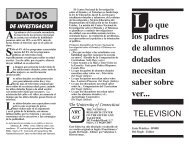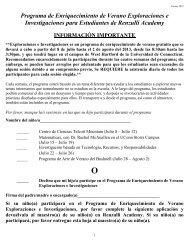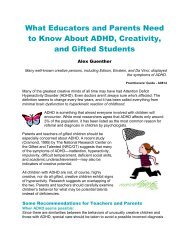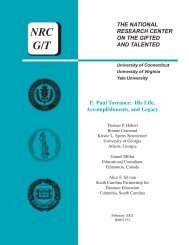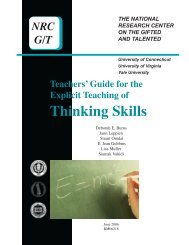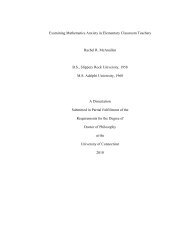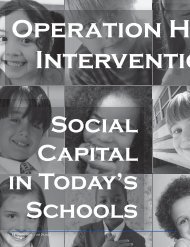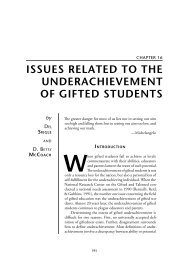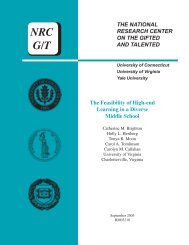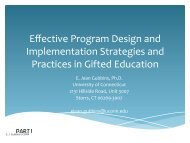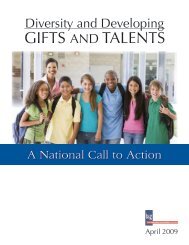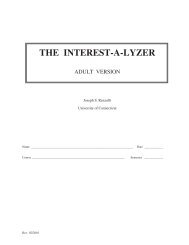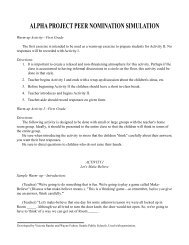Giftedness and High School Dropouts - Neag Center for Gifted ...
Giftedness and High School Dropouts - Neag Center for Gifted ...
Giftedness and High School Dropouts - Neag Center for Gifted ...
You also want an ePaper? Increase the reach of your titles
YUMPU automatically turns print PDFs into web optimized ePapers that Google loves.
27<br />
Research Question 2: Is there any difference between gifted dropouts <strong>and</strong><br />
non-gifted dropouts with respect to their plans to return school<br />
A chi-square analysis was conducted to examine differences between gifted<br />
students <strong>and</strong> non-gifted students who dropped out of school, with respect to their plans to<br />
return to school. The adequacy of expected frequencies was examined prior to the<br />
analysis, <strong>and</strong> no violation of assumptions was found. There was no significant difference<br />
between the two groups with respect to their plans to return to school, χ 2 (1, N=839)=.02,<br />
p=.88. As Table 6 indicates, only 35.9% of gifted students planned to return to school,<br />
while 64.2% had no plan to return to school. Similarly, 34.9% of non-gifted students<br />
planned to return to school, while 65.1% had no plan to return to school.<br />
Research Question 3: Is there any difference between gifted dropouts <strong>and</strong><br />
non-gifted dropouts with respect to their self-concept <strong>and</strong> locus of control<br />
To examine differences between gifted <strong>and</strong> non-gifted students who dropped out<br />
of school with respect to their self-concept <strong>and</strong> locus of control, a multivariate analysis of<br />
variance (MANOVA) was per<strong>for</strong>med. Prior to conducting the MANOVA, a principal<br />
factor analysis was per<strong>for</strong>med to determine the subscales of self-concept. A total of 13<br />
items from the NELS:88 questionnaire, which represent students' opinion about<br />
themselves <strong>and</strong> their attitudes, was included in the analysis. Results indicated that two<br />
factors were extracted, accounting <strong>for</strong> 45% of the variance. Loadings of variables on<br />
factors, percent of variance, <strong>and</strong> their reliabilities are presented in Table 7. To facilitate<br />
interpretation, factors below .45 were suppressed. Based on the theoretical grounds,<br />
factor 1 was labeled as self-concept <strong>and</strong> factor 2 was labeled as locus of control.<br />
A MANOVA was conducted to examine the differences in self-concept <strong>and</strong> locus<br />
of control between gifted <strong>and</strong> non-gifted students who dropped out of school. Results<br />
indicated that the combined dependent variables were significantly affected by the two<br />
groups (F=23.79, p



